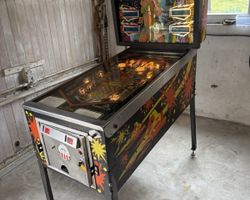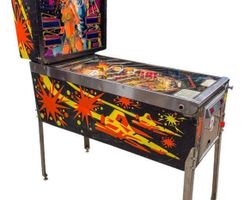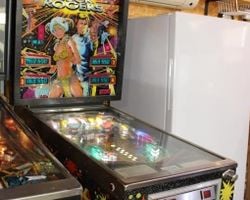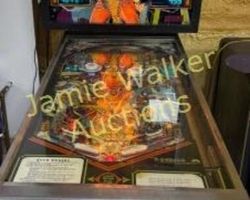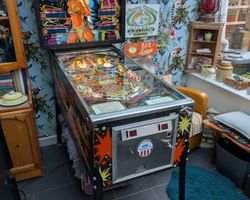Buck Rogers
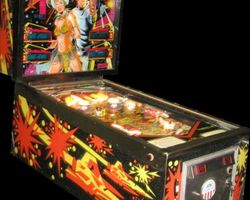
Average Prices: USD $200 to $1,300
Produced: January, 1980
Production Run: 7,410 units
Machine Type: Solid State Electronic
MPU: Gottlieb System 1
Players: 4
Design by: John Buras
Art by: Gordon Morison
Software by: John Buras
Gottlieb's "Buck Rogers," released in January 1980, transports players into a solid-state rendition of the popular science fiction universe. Manufactured by D. Gottlieb & Company, a prominent name in pinball production for decades, this machine arrived as part of their Gottlieb System 1 generation of electronic pinball games. With 7,410 units produced, "Buck Rogers" entered an evolving market, bringing the space adventure theme to the forefront of arcades and homes.
The machine's design and software were primarily handled by John Buras, who crafted the gameplay experience, while the distinct visual identity came from the brush of Gordon Morison, the artist responsible for the vibrant playfield and backglass artwork. Initially, during its development phase, this machine, designated Model #437, carried the working title "Par Four," a detail found in Gottlieb's engineering records, highlighting an internal shift in thematic direction before its final production name was settled. Its release marked Gottlieb's continued venture into the solid-state era, following a long history of electro-mechanical designs, demonstrating their adaptation to emerging technologies in pinball.
Signature Features and Design
"Buck Rogers" stands out with several characteristic elements, each contributing to its gameplay identity. Foremost among these is the unique vari-target, a mechanical device that responds dynamically to player input. Unlike a static target, the vari-target on "Buck Rogers" recedes further into the playfield each time it is struck, increasing its point value and demanding increasingly precise shots from the player. This mechanism creates a sense of escalating challenge and reward, making successful hits on it particularly satisfying.
Another key feature is the captive ball, which players can repeatedly strike against a bank of targets or a scoring switch. This allows for continuous scoring opportunities and often serves as a pathway to lighting other features on the playfield. The interplay between these mechanical elements, such as hitting drop targets to enable the vari-target or light the captive ball for increased value, forms the core of the machine’s engagement.
Beyond the mechanical innovations, the artwork by Gordon Morison defines the visual appeal of "Buck Rogers." Morison’s distinct style imbues the machine with a vibrant, colorful aesthetic. The backglass, in particular, often draws attention for its detailed depictions of characters and futuristic scenes, capturing the essence of the space adventure theme. This visual artistry, combined with the machine's interactive features, provides an immersive experience that complements the fast-paced gameplay.
Playfield and Mechanics
The "Buck Rogers" playfield layout is designed to encourage calculated shots and strategic target prioritization. Dominating key areas are multiple sets of drop targets: a 4-bank and two 2-bank configurations. Clearing these banks is fundamental to advancing score multipliers and lighting special features. Each set of targets typically guards valuable lanes or leads to a kick-out hole, which can award points or initiate specific game sequences.
Central to the playfield's flow is the vari-target, strategically positioned to be a primary focus for players. Successfully hitting this target multiple times not only increases its base value but can also be integral to activating bonus features or reaching score thresholds for extra balls or specials. The captive ball, often situated near other scoring opportunities, provides a repeatable target for players to accumulate points or activate hidden bonuses by striking it multiple times.
The two pop bumpers, classic pinball elements, are positioned to keep the ball in active play in the upper sections of the playfield, often deflecting it towards the drop targets or rollover lanes. A single slingshot provides dynamic rebound action, adding an element of unpredictability to ball movement, demanding quick reflexes from players. The manual plunger delivers the ball into play, often into rollover lanes that can light bonus multipliers or specific playfield features, setting the initial tone for each ball.
Gordon Morison’s artwork integrates seamlessly with these mechanical elements. The playfield is adorned with depictions of spacecraft, alien landscapes, and characters from the Buck Rogers universe. This rich, colorful aesthetic guides the player's eye towards the various targets and scoring opportunities, enhancing the thematic immersion. The lighting, though simpler than later solid-state games, effectively highlights active targets and scoring opportunities, providing clear visual feedback during gameplay. The overall design philosophy emphasizes a blend of precision shooting, strategic target prioritization, and reactive flipper work, creating a challenging yet rewarding experience.
Gameplay Dynamics
The gameplay dynamics of "Buck Rogers" revolve around a deceptively simple yet strategically deep scoring system that rewards accurate and repetitive shots. Players aim to clear the multiple banks of drop targets, as doing so is often tied to increasing bonus multipliers or lighting scoring opportunities elsewhere on the playfield. Each cleared bank contributes to building a potential score that is awarded at the end of the ball, encouraging players to focus on these objectives early in their turn.
The vari-target is a central scoring mechanism and a primary objective. Players are encouraged to repeatedly hit this target, as each successful strike increases its point value and, potentially, its physical retraction depth, making subsequent hits more challenging. This escalation of reward for precision provides a clear focal point for high-score attempts. Strategic play involves balancing attempts on the vari-target with clearing drop targets to maximize the end-of-ball bonus.
The kick-out hole typically serves as an entry point for a skill shot or a means to collect accumulated bonuses or light specials. Landing the ball in this hole requires precise flipper control, adding another layer of skill to the game. While the game provides straightforward objectives, the underlying rules offer strategic choices. For instance, players must decide whether to pursue the high-value vari-target or prioritize clearing drop targets for bonus multipliers, particularly as the game progresses and balls are limited. A common challenge observed in "Buck Rogers" is the balance between achieving a free game (special) and an extra ball, with the former often feeling more attainable than the latter, influencing players' long-term engagement. The game rewards sharp flipper skills, as weak flippers can render some of the more challenging shots, especially those aimed at the vari-target or distant drop targets, nearly impossible to execute effectively.
Reception and Legacy
"Buck Rogers" generally garners positive feedback from the pinball community, often recognized as a robust and entertaining solid-state machine, particularly for its era. Its primary strength, frequently highlighted, is the visual artistry of Gordon Morison. The backglass, in particular, is consistently praised for its vibrant colors, dynamic character depictions, and overall ability to capture the science fiction theme, often cited as one of the standout aspects of the machine's design. The unique vari-target mechanism is another strong point, providing a distinctive and engaging shot that differentiates the gameplay from other machines. Many players appreciate the layout for being unique and offering a refreshing departure from more conventional designs.
Despite appearing straightforward, the rules are often described as having surprising depth, providing strategic options that keep players engaged. The game's fast pace and demanding shot accuracy are also viewed as positives, requiring and rewarding a skilled player. The theme integration, drawing from the Buck Rogers universe, is generally well-received.
However, "Buck Rogers" is not without its criticisms. The original sound package is frequently cited as a significant weakness. Players often describe it as uninspired, lacking in complexity, and sometimes even "atrocious," with an absence of continuous background music or distinct character voices. This original audio experience is often considered below par compared to contemporaries. This shortcoming, however, is frequently mitigated by modern aftermarket sound upgrades, such as the Pascal Janin PI-1 board, which are noted to dramatically enhance the audio experience, aligning it more effectively with the engaging visuals and gameplay.
Another common point of contention revolves around the machine's reliance on properly maintained and strong flippers. If the flippers are not in peak condition, executing the crucial shots, especially those involving the vari-target or distant drop targets, becomes exceedingly difficult, effectively hindering core gameplay. Some players also note that certain areas of the playfield, particularly the upper left, can feel under-utilized or result in frustratingly quick drains. Furthermore, as an early Gottlieb System 1 machine, "Buck Rogers" is susceptible to the common electronic maintenance issues associated with that platform, such as corroded connectors and motherboard concerns, which require attention for reliable operation.
Despite these weaknesses, "Buck Rogers" maintains a respectable reputation within the pinball community. It stands as a solid example of Gottlieb's early solid-state efforts, showcasing their willingness to incorporate unique mechanical features like the vari-target. Its enduring appeal lies in its combination of engaging gameplay, distinctive artwork, and the potential for a significantly enhanced experience with modern sound modifications, securing its place as a collectible and enjoyable machine for enthusiasts of classic pinball.
Sponsored Links
 Ebay Listings
Ebay Listings
 Auction Results
Auction Results
| Cost | Location | Date |
|---|---|---|
| USD $3,495 |  Colorado, United States Colorado, United States |
28 September, 2025 |
| EUR €720 |  Baden-Württemberg, Germany Baden-Württemberg, Germany |
26 March, 2025 |
| USD $650 |  Delaware, United States Delaware, United States |
24 January, 2025 |
| GBP £1,220 |  Welling, United Kingdom Welling, United Kingdom |
07 December, 2024 |
| USD $1,400 |  Arizona, United States Arizona, United States |
15 October, 2024 |
| USD $3,950 |  South Dakota, United States South Dakota, United States |
26 October, 2023 |
| GBP £1,500 |  Sawbridgeworth, United Kingdom Sawbridgeworth, United Kingdom |
10 March, 2023 |
| USD $2,999 |  Pennsylvania, United States Pennsylvania, United States |
07 June, 2022 |
| AUD $3,500 |  New South Wales, Australia New South Wales, Australia |
01 May, 2022 |
| USD $2,100 |  Minnesota, United States Minnesota, United States |
04 March, 2022 |


Private Policy · Search Website · Contact Us
As an eBay Partner, we may earn a commission from qualifying purchases made through links on this site, at no additional cost to you.
All trademarks and copyrighted materials remain property of their respective owners. All other content copyright 2007 - 2025 Pinpedia.


